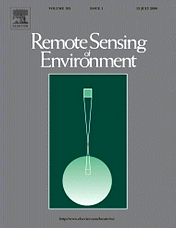Título
Radiation budget of vegetation canopies with reflective surface: A generalization using the Markovian approach
Alias
171101-01-articulo
Portada

Autores
José Luis Silván Cárdenas, Nirani Corona Romero.
Año
2017
Fecha
2017-11-01
Categoría
Artículos
Identificador
ISSN: 0034-4257 DOI: 10.1016/j.rse.2016.11.019
Hipervínculo
Hipervínculo revisado
01 Septiembre 2021
Abstract
Empirical and theoretical evidence has shown that the scattering and absorptance of a homogeneous leaf canopy with black soil can be modeled using simple algebraic combinations of two spectrally invariant parameters (the recollision probability and the canopy interceptance) and one spectrally dependent quantity (the single scattering albedo of an average phytoelement). This study generalizes such results for vegetation canopies composed of one or more types of phytoelements and with a reflective background surface also composed of one or more materials, all of which are treated as endmembers of a nonlinear spectral mixture. The conservative radiation field of a canopy is represented by a finite state Markov chain, such that for a vegetation-surface medium composed of m endmembers, the model is thereby parameterized in terms of an m-length vector of endmember interceptances and an mth-order square matrix containing probabilities of photon recollision amongst the endmembers. Comparisons of some instances of the model with radiative transfer based approximations showed how the latter may overestimate canopy reflectance and transmittance. The two-endmembers model was also compared with Monte Carlo simulations for spherically-oriented leaf canopies with reflective soil. Results indicated that the analytical model accurately describes the radiation field for a wide range of soil reflectance and LAI values. Simulations also showed that while the zenith angle of the illumination source has a small influence on the recollision probabilities, the LAI value mainly determines these through distinct functional relationships. The application of the model to estimate the canopy radiation field of two coniferous species located on the Mexico City Conservation Land is also demonstrated using airborne hyperspectral measurements.

